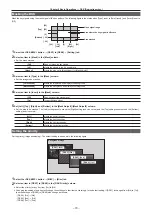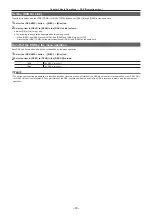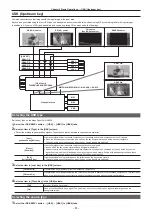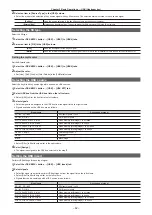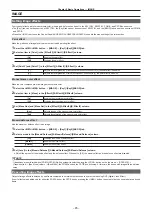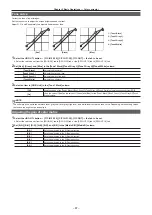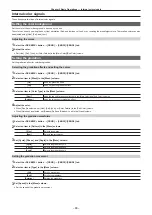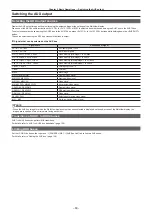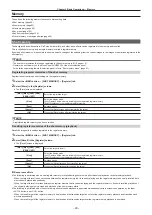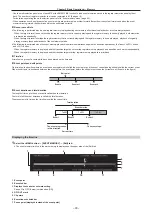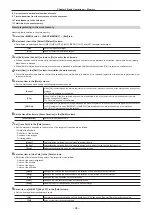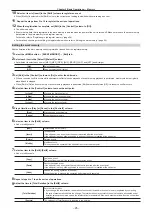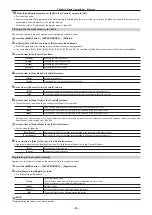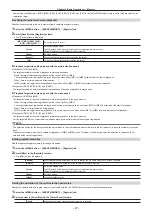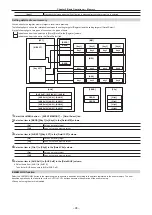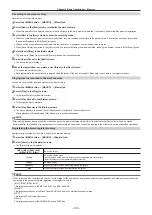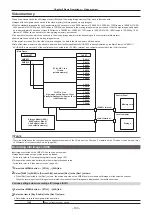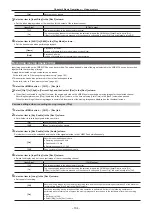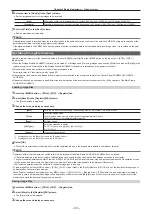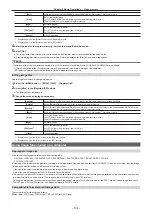
– 93 –
Chapter 5 Basic Operations — Memory
t
Use the multi-selection panel area of each ME or the EMEM LINK function to load event memories saved in the register memories and play them
back. The number of register memories that can be registered is 81 (9 pages
×
9).
For details on operating the multi-selection panel, refer to “Event memory menu” (page 42).
t
When operations such as playback of an event memory are performed in a system format different from the system format used when the event
memory was registered, the operations will not be performed correctly.
r
Resource conflicts
f
The following is performed when a new register memory is played during shot memory effect dissolve playback or event memory playback.
-
When the target to recall does not overlap the register memory that is currently playing and the register memory to be newly played, both memories
are played independently.
-
When the target to recall overlaps the register memory that is currently playing and the register memory to be newly played, playback of originally
playing memory stops and playback of the new memory starts.
f
The following is performed when the event memory playback is performed simultaneously with the transition operation by the fader, <AUTO> button,
and <CUT> button.
-
When the register memory to be played and the transition target do not overlap, register memory playback and transition each works independently.
-
When the register memory to be played and the transition target overlap, register memory playback is prioritized.
r
Timeline
A timeline is a group of events which have been placed on the time axis.
r
Event points and edit points
On a timeline, the position where an event has been registered is called the event point, and the event currently being edited is called the current event.
When the edit point is positioned between two event points, the event point before the edit point serves as the current event. (Event n in the figure)
Edit point
Event n
Event n+1
Event n+2
r
Event duration and total duration
The length of time up to the next event is called the event duration.
The total of all the event durations is called the total duration.
The present point in time on the timeline is called the current time.
1s00f
1s00f
1s00f
The event progresses
in this direction.
The event stops.
Total duration
Event duration
Current time
Event 1
Event 2
Event 3
Displaying the timeline
1
Select the <MEM> button
→
[EVENT MEMORY]
→
[Edit] tab.
f
The event memory timeline in the work memory is displayed on the upper area of the [Edit] tab.
4
1
2
8
9
10
11
3
5
6
7
1 Event point
2
Executed bar
3 Displays the current event mark setting.
Pause, Clip, GPO-Emem (omitted when [Off])
4 GPI‑OUT mark
5 Clip mark
6
Execution scheduled bar
7 Pause point (displayed instead of the event point)
Содержание AV-HS60C1E
Страница 5: ...Please read this chapter and check the accessories before use Chapter 1 Overview ...
Страница 32: ...This chapter describes basic operations and matters to be performed prior to use Chapter 4 Preparations ...
Страница 52: ...This chapter describes menu operations Chapter 5 Basic Operations ...
Страница 118: ...This chapter describes the input output signal settings Chapter 6 Input Output Signal Settings ...
Страница 129: ...This chapter describes how to operate the CONFIG menu displayed when the CONF button is pressed Chapter 7 CONFIG Menu ...
Страница 140: ...This chapter describes how to operate the system menu displayed when the SYS button is pressed Chapter 8 System Menu ...
Страница 162: ...This chapter describes the difference with the Standard mode Chapter 9 3G mode 4K mode ...
Страница 168: ...This chapter describes the terminals and signals of the unit Chapter 10 External Interfaces ...
Страница 173: ...This chapter describes the dimensions and specifications of this product Chapter 11 Specifications ...
Страница 184: ...This chapter describes the setting menu table and terms Chapter 12 Appendix ...
Страница 206: ...Web Site http www panasonic com Panasonic Corporation 2014 ...

